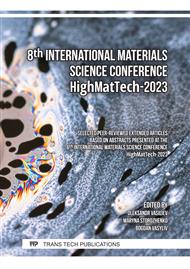[1]
K. Alves de Souza, A. Robin, Influence of concentration and temperature on the corrosion behavior of titanium, titanium-20 and 40% tantalum alloys and tantalum in sulfuric acid solutions, Mater. Chem. Phys. 103 (2007) 351-360.
DOI: 10.1016/j.matchemphys.2007.02.026
Google Scholar
[2]
S. Lavrys, I. Pohrelyuk, H. Veselivska, A. Skrebtsov, J. Kononenko, Y. Marchenko, Corrosion behavior of near-alpha titanium alloy fabricated by additive manufacturing, Mater. Corros. 73 (2022) 2063-2070.
DOI: 10.1002/maco.202213105
Google Scholar
[3]
I.N. Andijani, S. Ahmad, A.U. Malik, Corrosion behavior of titanium metal in the presence of inhibited sulfuric acid at 50°C, Desalination. 129 (2000) 45-51.
DOI: 10.1016/S0011-9164(00)00050-3
Google Scholar
[4]
M.A. Deyab, Corrosion inhibition of heat exchanger tubing material (titanium) in MSF desalination plants in acid cleaning solution using aromatic nitro compounds, Desalination. 439 (2018) 73-79.
DOI: 10.1016/j.desal.2018.04.005
Google Scholar
[5]
A. Imani, E. Asselin, Fluoride induced corrosion of Ti-45Nb in sulfuric acid solutions, Corros. Sci. 181 (2021) 109232.
DOI: 10.1016/j.corsci.2020.109232
Google Scholar
[6]
Z.B. Wang, H.X. Hu, Y.G. Zheng, W. Ke, Y.X. Qiao, Comparison of the corrosion behavior of pure titanium and its alloys in fluoride-containing sulfuric acid, Corros. Sci. 103 (2016) 50-65.
DOI: 10.1016/j.corsci.2015.11.003
Google Scholar
[7]
O. Ivasishin, V. Moxson, Low-cost titanium hydride powder metallurgy, in: M. Qian, F.H. (Sam) Froes (Eds.), Titanium Powder Metallurgy, Butterworth-Heinemann, 2015, pp.117-148.
DOI: 10.1016/B978-0-12-800054-0.00008-3
Google Scholar
[8]
G. Ma, T. Cheng, H. Jia, L. Yuan, O.M. Ivasishin, D.G. Savvakin, A novel method to fabricate high strength and ductility Ti-3Al-5Mo-4.5 V alloy based on TiH2 and pre-hydrogenated master alloy powders, Mater. Des. 227 (2023) 111791.
DOI: 10.1016/j.matdes.2023.111791
Google Scholar
[9]
T. Chen, C. Yang, Z. Liu, H.W. Ma, L.M. Kang, Z. Wang, W.W. Zhang, D.D. Li, N. Li, Y.Y. Li, Revealing dehydrogenation effect and resultant densification mechanism during pressureless sintering of TiH2 powder, J. Alloys Compd. 873 (2021) 159792.
DOI: 10.1016/j.jallcom.2021.159792
Google Scholar
[10]
J.H. Zhao, Z.L. Xie, T. Zhong, T. Sun, K. Fezzaa, Y. Cai, J.Y. Huang, S.N. Luo, Strain rate effects on the mechanical behavior of porous titanium with different pore sizes, Mater. Sci. Eng. A. 821 (2021) 141593.
DOI: 10.1016/j.msea.2021.141593
Google Scholar
[11]
M. Cheng, Z. Lu, J. Wu, R. Guo, J. Qiao, L. Xu, R. Yang, Effect of thermal induced porosity on high-cycle fatigue and very high-cycle fatigue behaviors of hot-isostatic-pressed Ti-6Al-4V powder components, J. Mater. Sci. Technol. 98 (2022) 177-185.
DOI: 10.1016/j.jmst.2021.04.066
Google Scholar
[12]
F. Cao, P. Kumar, M. Koopman, C. Lin, Z.Z. Fang, K.S. Ravi Chandran, Understanding competing fatigue mechanisms in powder metallurgy Ti–6Al–4V alloy: Role of crack initiation and duality of fatigue response, Mater. Sci. Eng. A. 630 (2015) 139-145.
DOI: 10.1016/j.msea.2015.02.028
Google Scholar
[13]
I. Pohrelyuk, S.Lavrys, K. Shliakhetka, D. Savvakin, O. Tkachuk, Influence of manufacturing parameters on microstructure evolution and corrosion resistance of powder metallurgy titanium, JOM. 75 (2022), 816-824.
DOI: 10.1007/s11837-022-05627-z
Google Scholar
[14]
F. Xie, X. He, S. Cao, M. Mei, X. Qu, Influence of pore characteristics on microstructure, mechanical properties and corrosion resistance of selective laser sintered porous Ti–Mo alloys for biomedical applications, Electrochim. Acta. 105 (2013) 121-129.
DOI: 10.1016/j.electacta.2013.04.105
Google Scholar
[15]
K. Shliakhetka, I. Pohrelyuk, H. Chumalo, R. Proskurnyak, S. Lavrys, H. Veselivska, Influence of concentration of sulfuric and hydrochloric acids on corrosion resistance of porous titanium, J. Mater. Sci. 58 (2023) 15047–15060.
DOI: 10.1007/s10853-023-08964-9
Google Scholar
[16]
D. Prando, A. Brenna, M.V. Diamanti, S. Beretta, F. Bolzoni, M. Ormellese, Ma.P. Pedeferri, Corrosion of titanium: Part 1: aggressive environments and main forms of degradation, J. Appl. Biomater. Funct. Mater. 15 (2017) e291-e302.
DOI: 10.5301/jabfm.5000387
Google Scholar
[17]
L. Casanova, M. Gruarin, M.P. Pedeferri, M. Ormellese, A comparison between corrosion performances of titanium grade 2 and 7 in strong reducing acids, Mater. Corros. 72 (2021) 1506–1517.
DOI: 10.1002/maco.202112392
Google Scholar
[18]
S. Dong, T. Cheng, X. Wang, D. Savvakin and O. Ivasishin, Effect of master alloys on synthesis and mechanical properties of Ti-6Al-4V alloy produced by elemental powder blends, JOM. 74 (2022) 4389-4401.
DOI: 10.1007/s11837-022-05386-x
Google Scholar
[19]
A.C. Alves, I. Sendão, E. Ariza, F. Toptan, P. Ponthiaux, A. M.P. Pinto, Corrosion behaviour of porous Ti intended for biomedical applications, J. Porous Mater. 23 (2016) 1261-1268.
DOI: 10.1007/s10934-016-0185-0
Google Scholar
[20]
M.E. Straumanis, P.C. Chen, The corrosion of titanium in acids – The rate of dissolution in sulfuric, hydrochloric, hydrobromic and hydroiodic acids. Corrosion. 7 (1951) 229-237.
DOI: 10.5006/0010-9312-7.7.229
Google Scholar



